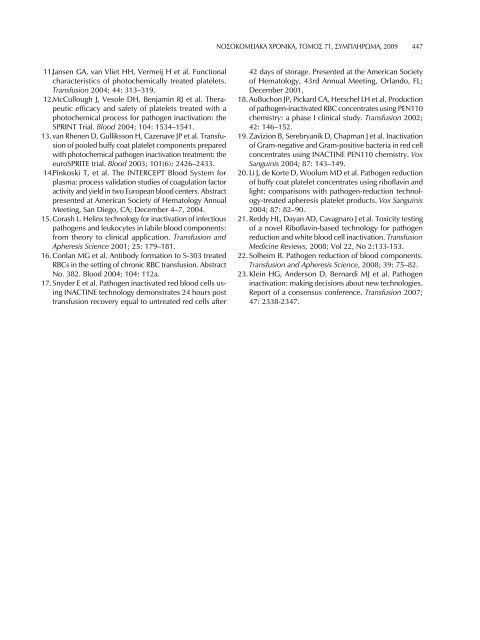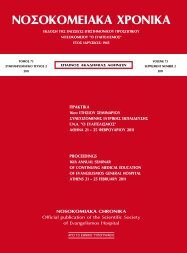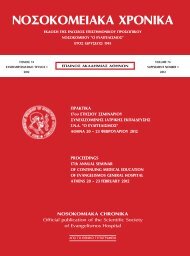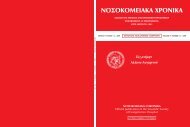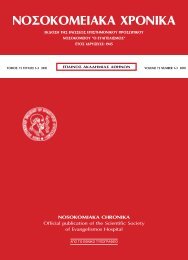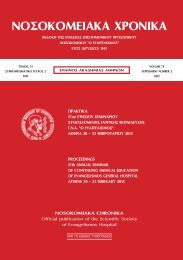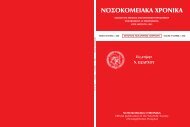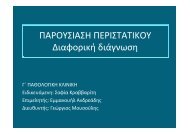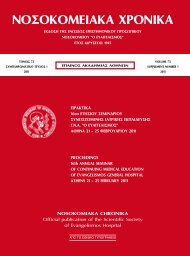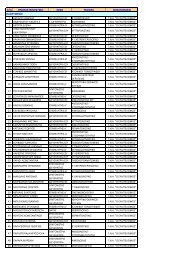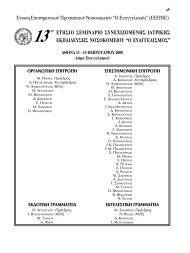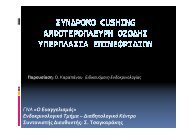åêðáéäåõóçó γ.ν.α.
åêðáéäåõóçó γ.ν.α.
åêðáéäåõóçó γ.ν.α.
Create successful ePaper yourself
Turn your PDF publications into a flip-book with our unique Google optimized e-Paper software.
ΝΟΣΟΚΟΜΕΙΑΚΑ ΧΡΟΝΙΚΑ, ΤΟΜΟΣ 71, ΣΥΜΠΛΗΡΩΜΑ, 2009<br />
447<br />
11. Jansen GA, van Vliet HH, Vermeij H et al. Functional<br />
characteristics of photochemically treated platelets.<br />
Transfusion 2004; 44: 313–319.<br />
12.McCullough J, Vesole DH, Benjamin RJ et al. Therapeutic<br />
efficacy and safety of platelets treated with a<br />
photochemical process for pathogen inactivation: the<br />
SPRINT Trial. Blood 2004; 104: 1534–1541.<br />
13. van Rhenen D, Gulliksson H, Cazenave JP et al. Transfusion<br />
of pooled buffy coat platelet components prepared<br />
with photochemical pathogen inactivation treatment: the<br />
euroSPRITE trial. Blood 2003; 101(6): 2426–2433.<br />
14.Pinkoski T, et al. The INTERCEPT Blood System for<br />
plasma: process validation studies of coagulation factor<br />
activity and yield in two European blood centers. Abstract<br />
presented at American Society of Hematology Annual<br />
Meeting, San Diego, CA; December 4–7, 2004.<br />
15. Corash L. Helinx technology for inactivation of infectious<br />
pathogens and leukocytes in labile blood components:<br />
from theory to clinical application. Transfusion and<br />
Apheresis Science 2001; 25: 179–181.<br />
16. Conlan MG et al. Antibody formation to S-303 treated<br />
RBCs in the setting of chronic RBC transfusion. Abstract<br />
No. 382. Blood 2004; 104: 112a.<br />
17. Snyder E et al. Pathogen inactivated red blood cells using<br />
INACTINE technology demonstrates 24 hours post<br />
transfusion recovery equal to untreated red cells after<br />
42 days of storage. Presented at the American Society<br />
of Hematology, 43rd Annual Meeting, Orlando, FL;<br />
December 2001.<br />
18. AuBuchon JP, Pickard CA, Herschel LH et al. Production<br />
of pathogen-inactivated RBC concentrates using PEN110<br />
chemistry: a phase I clinical study. Transfusion 2002;<br />
42: 146–152.<br />
19. Zavizion B, Serebryanik D, Chapman J et al. Inactivation<br />
of Gram-negative and Gram-positive bacteria in red cell<br />
concentrates using INACTINE PEN110 chemistry. Vox<br />
Sanguinis 2004; 87: 143–149.<br />
20. Li J, de Korte D, Woolum MD et al. Pathogen reduction<br />
of buffy coat platelet concentrates using riboflavin and<br />
light: comparisons with pathogen-reduction technology-treated<br />
apheresis platelet products. Vox Sanguinis<br />
2004; 87: 82–90.<br />
21. Reddy HL, Dayan AD, Cavagnaro J et al. Toxicity testing<br />
of a novel Riboflavin-based technology for pathogen<br />
reduction and white blood cell inactivation. Transfusion<br />
Medicine Reviews, 2008; Vol 22, No 2:133-153.<br />
22. Solheim B. Pathogen reduction of blood components.<br />
Transfusion and Apheresis Science, 2008; 39: 75–82.<br />
23. Klein HG, Anderson D, Bernardi MJ et al. Pathogen<br />
inactivation: making decisions about new technologies.<br />
Report of a consensus conference. Transfusion 2007;<br />
47: 2338-2347.<br />
xxxxxxxxxxx<br />
xxxxxx


